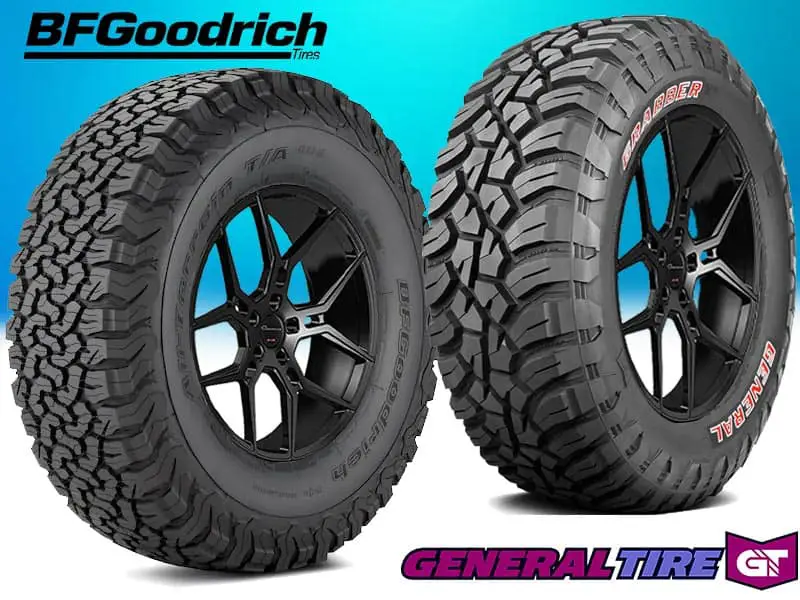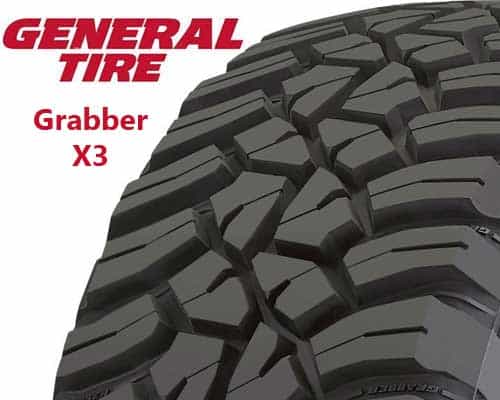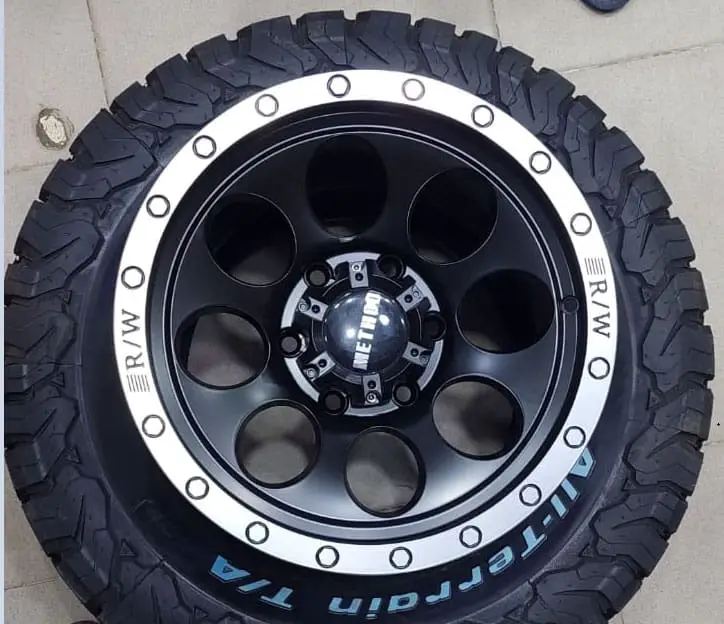The General Grabber X3 is a Mud-Terrain (M/T) tire designed for extreme off-road traction, while the BFGoodrich KO2 is an All-Terrain (A/T) tire that strikes a balance between on and off-road performance.
Both tires boast unique features and designs that position them as top-tier options in their respective categories.

Before we delve deeper, it’s essential to consider these additional tire comparisons involving the KO2, as they provide valuable insights into its performance:
Table of Contents
Thing to know about General Grabber X3
The Grabber X3 features an aggressive symmetrical 4-pitch tread design with a higher void ratio, resulting in minimal road contact.

As a consequence, its on-road dry traction is reduced, making it less suitable for paved surfaces.
However, its wider grooves and full-depth sipes enhance wet traction by efficiently channeling water away.
Chamfered blocks and notches in the tread design provide enhanced grip on loose surfaces, and wide grooves effectively clear mud and soft snow, enhancing off-road capabilities.
Mud traction is further improved by the open shoulder design, allowing mud to escape easily and maintain cleaning action.
However, the Grabber X3 struggles on icy roads due to its lower contact patch, leading to reduced grip in such conditions.
Bold stone ejectors between the shoulder stud grooves prevent stones from getting stuck and enhance rock traction. The tire also features extra sidewall protective lugs for added durability in harsh terrain.
Its robust compound increases treadwear resistance, and a 3-ply body casing with twin steel belts bolsters off-road durability.
While it may be noisy on-road, it delivers a smooth off-road ride.
Things to know about BF Goodrich KO2
The KO2 features a less aggressive symmetrical 5-pitch tread design with a significantly lower void ratio, resulting in a larger contact patch and improved on-road dry traction.

However, its wet traction is lower due to narrower grooves, and multiple shallow sipes don’t significantly enhance wet performance.
The tire’s off-roading capabilities are limited by its narrow grooves, which are less effective at clearing mud, soft snow, and gravel.
The shoulders are not as open, further hindering mud clearance.
Stone ejectors between the shoulder stud grooves are less bold than those of its competitor, resulting in lower rock traction. The KO2 is made from a racing-derived tread compound that’s cut and chip-resistant, improving treadwear resistance.
It features 2 steel belts with nylon reinforcements and 3-ply polyester cord sidewalls, offering durability, although not as high as the X3.
On-road, it’s quiet, but it may not provide the smoothest off-road ride.
On-Road Traction
The X3’s higher void ratio decreases road contact, reducing grip and increasing braking distance, leading to poor on-road dry traction. However, it excels on wet roads, thanks to its wider grooves, which efficiently clear water.
The KO2’s lower void ratio enhances road grip due to a larger contact patch, resulting in shorter braking distances and improved on-road dry traction. However, its wet traction is compromised by narrow grooves, putting it at risk of hydroplaning.
Off-Road Traction
In mud, the X3’s wider grooves allow it to navigate effectively, biting into mud and throwing it backward, maintaining tire movement. The open shoulder design further improves mud traction.
The KO2’s narrow grooves struggle with mud, as they are less effective at clearing it, increasing the risk of getting stuck. It performs better on ice due to a larger contact patch and multiple sipes.
Rock Terrain
The X3 is well-equipped for rocky terrain with bold stone ejectors to prevent stones from getting stuck in the grooves, ensuring excellent protection against trail damages.
The KO2’s less bold stone ejectors make it perform less effectively on rocks, as it may struggle to prevent stones from puncturing the tire.
Brand Comparison
The choice between the two brands often comes down to specific driving needs and preferences, with General Tire offering a good balance for everyday driving, while BFGoodrich excels in off-road and challenging terrain applications.
History
General Tire, with a heritage dating back to 1915, is an American tire brand known for its longevity in the industry.
On the other hand, BFGoodrich, established in 1870, holds the distinction of being one of the oldest tire manufacturers in the United States.
Both brands have a deep-rooted history, reflecting their experience and expertise in the tire industry.
Performance
General Tire focuses on delivering a balanced combination of performance and affordability across a diverse range of tire products, making them suitable for a wide consumer base seeking reliable and cost-effective options.
In contrast, BFGoodrich has a strong reputation for exceptional off-road and rugged terrain performance, particularly in motorsport and off-road racing scenarios.
BFGoodrich tires are known for their durability and resilience in challenging conditions, appealing to off-road enthusiasts and adventurers.
Innovation
Both General Tire and BFGoodrich prioritize innovation in tire technology. General Tire has introduced features like advanced tread designs, silica-based compounds, and 3D sipe technology to enhance the performance and safety of their tires.
BFGoodrich, with a history deeply rooted in off-road excellence, continues to innovate with technologies such as CoreGard, which enhances tire toughness, and advanced rubber compounds for improved traction.
Both brands are committed to advancing tire technology to meet the evolving needs of consumers.
Durability and Treadwear
The X3 offers greater durability due to its robust build and lower rolling resistance. Its limited tread contact with the ground results in lower treadwear. It features a robust compound and a 3-ply body casing with twin steel belts, ensuring better durability and mileage.
The KO2, while durable, compromises between flexibility and rigidity, resulting in lower durability compared to the X3. It has a higher contact patch, leading to higher rolling resistance and increased treadwear. It features a racing-derived tread compound, 2 steel belts with nylon reinforcements, and 3-ply polyester cord sidewalls.
Comfort
The X3 is less comfortable on-road due to its wider grooves, resulting in more noise. However, off-road, these grooves act as shock absorbers, reducing the impact of jerks and improving reliability.
The KO2 is a more balanced tire for on and off-roading, producing less noise on-road, especially at high speeds. Off-road comfort is not its strong suit, as narrow grooves do not dampen jerks effectively.
Price Differences
The X3, being a Mud-Terrain tire, is typically priced higher than the All-Terrain KO2. X3 is favored by off-roading enthusiasts, while the KO2 offers a compromise between on and off-road performance.
Quick Summary
Ultimately, your choice between the two tires should align with your specific on and off-road driving needs and preferences. Though let me summarize things for you quickly.
- X3 is a Mud-Terrain tire, while KO2 is an All-Terrain tire.
- KO2 performs better on-road, while X3 excels off-road.
- X3 is better equipped for wet conditions.
- X3 handles mud and soft snow effectively.
- KO2 provides better traction on ice.
- X3 has superior rock-crawling capabilities.
- X3 offers higher durability and mileage.
- KO2 is quieter on-road.
- X3 is higher priced due to its extreme off-road capabilities.